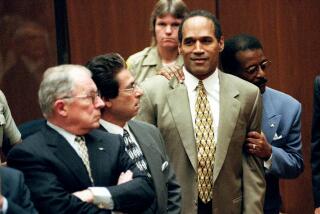Suspect’s Murder Retrial Begins--24 Years Later
- Share via
SALINAS, Calif. — In 1962, Booker Hillery, who was accused of fatally stabbing a 15-year-old girl, sat in a small Hanford courtroom and listened to attorneys make their opening statements.
On Monday, Hillery, on trial again for the same crime, sat in another courtroom, in another city, and listened to another opening statement.
He was convicted in the first trial and has served 24 years in prison. But 10 months ago the U.S. Supreme Court ruled that Hillery, a black farmhand accused of killing a white girl, had been unconstitutionally discriminated against because blacks were purposely excluded from the Kings County Grand Jury that indicted him. The court ordered that Hillery be freed or given a new trial.
And in Monterey County Superior Court, attorneys Monday addressed the unusual, and they say unprecedented, nature of the case.
Kings County Dist. Atty. Robert R. Maline, who is prosecuting Hillery, re-created for the jury in his opening statement the events of March 21, 1962, the night Marlene Miller was killed. But much has changed in the past 24 years.
Maline has had to create a model of the murder site because where the house once stood there is now an equipment shed. And a number of key witnesses, who testified in 1962, have died, so Kings County hired two women to read the transcripts of their testimony.
“You lose a lot of the vividness, and the case is a lot drier for the jury,” said Maline after his opening statement. “You don’t see the person’s face or hear their voice. But, hopefully, a good jury can go beyond that.”
Citing the time between trials, Hillery’s attorney, Clifford Tedmon, declined to give an opening statement.
“If the crime had just occurred, I’d probably give one,” Tedmon said. “But with two trials 24 years apart, there will probably be a lot of fumbling around with exhibits. The lawyers will be confused; the jury will be completely confused.
“With a case like this, it’s not a good idea to talk too much in advance. We want to wait and see what the prosecutors come up with.”
After the opening statement, the scenario in the courtroom seemed more like a play rehearsal than a trial. The first witness called, Sidney Dougherty, the Kings County surveyor at the time of the murder, died eight years ago.
His testimony was read by one of the women hired by the county. And Santa Rosa attorney Ronald W. Fahey, a special prosecutor who is trying the case with Maline, read the same questions posed by the district attorney 24 years ago.
“In a way it’s like acting because you’re reading a script,” said Deborah Graves, a former employee of a court reporting firm who was hired to read the testimony. “We’ve done a lot of preparation because we want to get the words and syntax just right.”
Trying a case so many years after the original crime is an overwhelming task, attorneys on both sides said. They have pored over 6,000 pages of transcripts from the trial and two additional penalty phase trials, held as a result of appeals. About 115 people who were originally involved in the case--witnesses, law enforcement officers, family members, criminalists--had to be tracked down throughout the country. Twenty-one had died; others were senile.
But amid all the changes over the years the evidence was kept intact.
On Monday, six pieces of evidence retained since 1962 were shown to the jury: black-and- white photographs of Hillery’s car and the murder site, and four diagrams of the area.
At the time, residents say, the murder was the most shocking crime in the history of Hanford, a farming city of 24,000 in the San Joaquin Valley. Now, 24 years later, few have forgotten the case. As a result, a change of venue to Salinas was granted.
More to Read
Sign up for Essential California
The most important California stories and recommendations in your inbox every morning.
You may occasionally receive promotional content from the Los Angeles Times.










